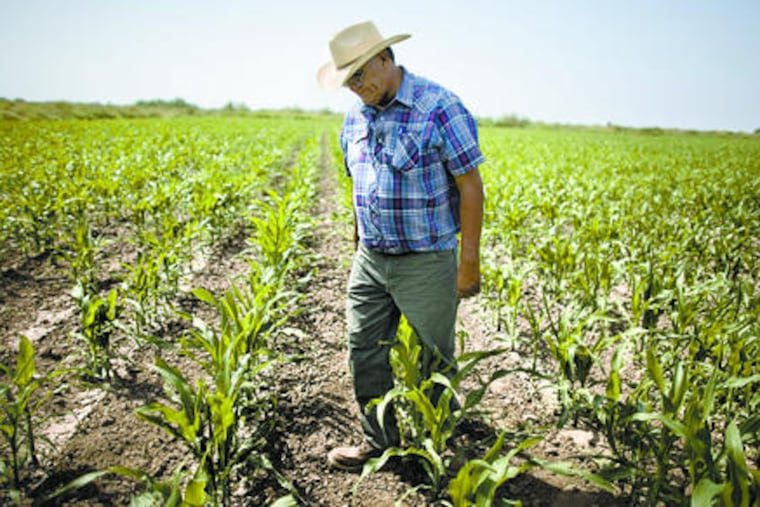Mexican food-crisis lessons
An agricultural breakthrough in the 1940s saved many from starvation. Another is needed.

CIUDAD OBREGON, Mexico - On the walls of some farmhouses here, a photo of a onetime Iowa farm boy hangs along with a portrait of the pope. The American long ago wrought a kind of miracle in the wheat fields of this valley, one that today's world hungers for anew.
After the pioneering agronomist Norman E. Borlaug introduced his "green revolution" of hardier seeds and chemicals in northern Mexico's soil more than 60 years ago, he was credited with saving hundreds of millions from starvation worldwide. Today, in a global food crisis of lagging productivity and punishing prices, world leaders are calling for a second revolution.
"These are life-and-death matters that we must confront," says U.N. Secretary-General Ban Ki-moon.
But Borlaug's scientific heirs say it won't be so easy this time, especially in Africa, where food production is growing only 2 percent a year, while population expands by 3 percent.
Even here in Mexico, in this vibrant wheat belt crisscrossed by tractors and crop dusters, farmers are in a daily struggle. Climate change is blamed for more frequent droughts, hotter temperatures, and the spread of new plant diseases. The cost of fertilizers has tripled, and their overuse has depleted soils, spewed more greenhouse gas into the skies and polluted water with farm runoff.
Numerous facets
"It was a clearer agenda when Dr. Borlaug was here: The goal was to produce more food, period," said Tom Payne of the Mexico-based International Maize and Wheat Improvement Center. "Now our agenda has kind of brought in a lot of different facets that make it a lot more difficult."
Matthew Reynolds, a wheat physiologist at the center, said the next green revolution needs to mix tried-and-true technologies with sustainable practices, or the world will be fighting famine again in another 50 years.
"We applied the Industrial Revolution model to the green agricultural revolution and we went a little bit too far in that direction, and now we have to back off a bit and respect the fact that the plants and the soil are biological," he said. "They are not engineering problems. They're more complex."
The center in Texcoco, near Mexico City, was the outgrowth of Borlaug's work here in Sonora state's Yaqui Valley, where he developed his seed varieties and launched his revolution, giving farmers in the developing world 20th-century technology - disease-resistant crops, fertilizers, fungicides.
His innovations were credited with staving off Asian famine in the 1960s and allowing harvests to outpace population growth for 40 years, and won the Iowa-born plant breeder, now 94 and ailing, the Nobel Peace Prize.
Multiple problems
Borlaug-inspired programs are trying to lift those farmers' productivity, but resources are short, and roads and other infrastructure weak. Meanwhile, global grain prices that skyrocketed in the last two years have pushed millions more Africans below the hunger line.
Oil prices, market speculation, and bigger appetites in China and other industrializing nations all contributed to that price spike. But experts looking ahead see further trouble globally: the lag in growth of per-acre farm output, water shortages, shifts in agricultural zones and rainfall patterns because of global warming.
The small farmers of Africa, likely to be hardest hit by these problems, may be worlds away from growers here who spend their days in air-conditioned pickups reading messages on their BlackBerrys. But there are lessons to be shared.
Yaqui growers don't only swap information at local coffee shops about the best seeds and techniques. They travel the globe to share experiences on how farmers themselves pour their profits into research and participate in experiments - which is key as governments reduce spending on agriculture.
Meanwhile, seeds of the latest disease-resistant wheat varieties developed in Mexico are being shipped worldwide as another catastrophic pathogen, UG99, threatens to devastate the world's second-most-important food source, after rice.
New varieties are developed using Borlaug's technique of "shuttle breeding." Researchers first grow prototypes in central Mexico in the summer and then rush those seeds to the Yaqui Valley for the winter, squeezing two growing seasons into one year and halving the time it takes to develop hybrids.
It's a conventional process that differs from the advanced, internationally controversial techniques of genetic engineering.
About 184,000 unique corn and wheat seeds are stored in refrigerated vaults at the research center, giving the world access to a vast library of plant genes to mix and match in search of increasing yields.